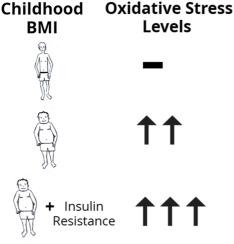Free Radical Biology and Medicine ( IF 7.1 ) Pub Date : 2020-05-25 , DOI: 10.1016/j.freeradbiomed.2020.05.009 Anna Jørs 1 , Morten A V Lund 1 , Thomas Jespersen 2 , Torben Hansen 3 , Henrik E Poulsen 4 , Jens-Christian Holm 5

|
Purpose
Oxidative stress may play an important role in childhood obesity and increased cardiometabolic risk. 8-oxo-7,8-dihydroguanosine (8-oxoGuo) from oxidation of RNA and 8-oxo-7,8-dihydro-2′-deoxyguanosine (8-oxodG) from oxidation of DNA are excreted into urine and function as biomarkers for oxidative stress reflecting the modification rate of nucleic acids by oxidation. This study investigates the associations between urinary markers of nucleic acid oxidation and Body Mass Index (BMI), age, sex and cardiometabolic risk factors in children and adolescents with and without obesity.
Methods
We studied 543 children and adolescents from an obesity clinic cohort (n = 418) and a population-based cohort (n = 125), all aged 6–18 years. Anthropometrics, urine and blood samples were collected. A validated liquid chromatography-tandem mass spectrometry method was used to measure the nucleic acid oxidation markers.
Results
Compared with the population-based cohort, children and adolescents in the obesity clinic cohort had higher calculated 24-h excretion of 8-oxoGuo (p = 0.045) and 8-oxodG (p = 0.014) adjusted for basal metabolic rate. Both oxidation markers were positively associated with age and female sex (all p < 0.002). In the obesity clinic cohort the RNA oxidation marker 8-oxoGuo correlated with serum insulin (rho = 0.18, p = <.001) and insulin resistance (rho = 0.19, p = <.001).
Conclusions
Childhood obesity associate with higher urinary excretion of nucleic acid oxidation biomarkers, and increase with age throughout childhood, mirroring the obesity- and age-related increase shown in adults. Finally, children with obesity and insulin resistance had higher RNA oxidation markers than children with obesity and no insulin resistance, supporting a possible link between oxidative stress and the pathogenesis of cardiometabolic risk including type 2 diabetes.
中文翻译:

丹麦儿童和青少年中,核酸氧化的尿标随年龄,肥胖和胰岛素抵抗而增加。
目的
氧化应激可能在儿童肥胖和增加心脏代谢风险中起重要作用。RNA氧化产生的8-oxo-7,8-dihydroguanosine(8-oxoGuo)和DNA氧化产生的8-oxo-7,8-dihydro-2'-deoxyguanosine(8-oxodG)被排入尿液并用作生物标记物氧化应激反应反映了核酸通过氧化的修饰率。这项研究调查了有无肥胖症的儿童和青少年的尿液核酸氧化标志物与体重指数(BMI),年龄,性别和心脏代谢危险因素之间的关系。
方法
我们研究了来自肥胖诊所队列(n = 418)和人群队列(n = 125)的543名儿童和青少年,年龄均在6-18岁之间。收集人体测量学,尿液和血液样本。验证的液相色谱-串联质谱法用于测量核酸氧化标记。
结果
与以人群为基础的队列相比,肥胖门诊队列中的儿童和青少年的24小时排泄量经基础代谢率调整的8-oxoGuo(p = 0.045)和8-oxodG(p = 0.014)更高。两种氧化标记物均与年龄和女性呈正相关(所有p <0.002)。在肥胖症诊所队列中,RNA氧化标记物8-oxoGuo与血清胰岛素(rho = 0.18,p = <.001)和胰岛素抵抗(rho = 0.19,p = <.001)相关。
结论
儿童肥胖与核酸氧化生物标记物的尿液排泄量增加有关,并且随着儿童整个年龄的增长而增加,反映出成年人中与肥胖和年龄相关的增长。最后,肥胖和胰岛素抵抗的患儿比肥胖和无胰岛素抵抗的患儿具有更高的RNA氧化标记,支持氧化应激与包括2型糖尿病在内的心脏代谢风险的发病机制之间的可能联系。









































 京公网安备 11010802027423号
京公网安备 11010802027423号